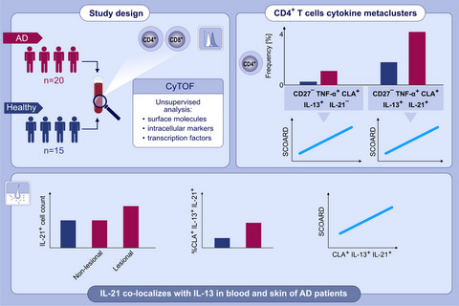Release date:2021-11-19

Allergy
[IF: 13.146]
High-dimensional analysis defines multicytokine T-cell subsets and supports a role for IL-21 in atopic dermatitisDOI: 10.1111/all.14845
Abstract:
Background: Flow cytometry is a well-accepted approach for immune profiling; however, its value is restricted by the limited number of markers that can be analyzed simultaneously. Mass cytometry/CyTOF offers broad-scale immune characterization integrating large number of parameters. While partial blood phenotyping was reported in atopic dermatitis (AD), patients’ comprehensive profiling, critical for leveraging new targeted treatments, is not available. IL-21 may be involved in inflammatory skin diseases but its role in AD is not well established.
Methods: We studied T-cell polarization in the blood of 20 moderate-to-severe AD and 15 controls. Using CyTOF and an unsupervised analysis, we measured the frequencies and mean metal intensities of activated polar CD4+/CD8+ T-cell subsets. Immunohistochemistry, immunofluorescence, and qRT-PCR were used to analyze skin samples.
Results: Examining 24 surface, intracellular markers, and transcription factors, we identified six CD4+ and five CD8+ T-cell metaclusters. A CD4+ skin-homing IL-13+monocytokine and a novel IL-13+IL-21+ multicytokine metaclusters were increased in AD vs. controls (p < .01). While IL-13 signature characterized both clusters, levels were significantly higher in the IL-21+ group. Both clusters correlated with AD severity (r = 0.49, p = .029). Manual gating corroborated these results and identified additional multicytokine subsets in AD. Immunohistochemistry and immunofluorescence, validated by mRNA expression, displayed significantly increasedIL-21 counts and colocalization with IL-13/IL-4R in AD skin.
Conclusion: A multicytokine signature characterizes moderate-to-severe AD, possibly explaining partial therapeutic responses to one cytokine targeting, particularly in severe patients. Prominent IL-21 signature in blood and skin hints for a potential pathogenic role of IL-21 in AD.
First Author:
Tali Czarnowicki
Correspondence:
Emma Guttman-Yassky, The Kimberly and Eric J. Waldman Department of Dermatology, Icahn School of Medicine at Mount Sinai, 1425 Madison Avenue, Box 1047, New York, NY 10029-6574, USA.
2021-10-27 Article
 hth官方网页版中国有限公司
hth官方网页版中国有限公司
